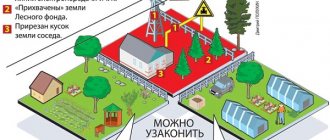It is not enough to simply own a piece of land for a long time. Sooner or later you will need to confirm your ownership. What are the title documents for land in 2020?
Dear readers! The article talks about typical ways to resolve legal issues, but each case is individual. If you want to find out how to solve your particular problem , contact a consultant:
8 (800) 700 95 53
APPLICATIONS AND CALLS ARE ACCEPTED 24/7 and 7 days a week.
It's fast and FREE !
Purchasing land for homestead farming, inheriting a private house, acquiring a land plot as a gift. Any fact of obtaining land requires documentary support.
The most questions are raised by confirmation of ownership and the basis for its occurrence. What title documents for a land plot should the owner have in 2020?
General points
In order to become the owner of land, it is not enough to buy it. Clause 1 of Article 130 of the Civil Code of the Russian Federation classifies plots of land as immovable things.
According to Article 130 of the Civil Code, ownership and other property rights to real estate, as well as any changes relating to rights, are certainly subject to state registration in the state register.
When purchasing a plot of land, you must ask the previous owner to present documents indicating the existence of legal rights to the property.
These are legal and title documents. Most fraudulent land transactions are based on insufficient knowledge of the buyers.
People know that some document must be present. But they are usually content with a legal document.
This is a certificate of state registration of property rights.
But rarely anyone is interested in title documents. The absence of such may lead to a challenge to the right of ownership by other persons.
What it is
Title documentation is otherwise called foundation documents. Their content implies the right of a certain person to a specific piece of land.
These are documents on the basis of which the subject received ownership of land.
For example, an alienation agreement, a certificate of inheritance, a resolution of the local administration and much more.
How to determine which document is the title document? After its analysis, it should be extremely clear who, to whom, when and what was transferred.
All title documents are an integral part of the main agreement in land transactions. Based on these documents, the process of registering property rights is implemented.
Any title documents require particularly careful study to ensure compliance with legal regulations.
What is it for
First of all, when checking title documents, you need to ensure their authenticity. But this is not the main thing. Even real documents do not always guarantee the security of a transaction.
Each such document should be considered for the possibility of property claims by third parties.
For example, the owner received ownership rights based on a court decision. But any decision of the judiciary can be challenged.
Moreover, legal proceedings can last for years. The losing party only has six months to file a complaint in court.
During this time, it is quite possible to register ownership and sell the land. The new owner, in addition to the property, acquires an “add-on” in the form of litigation.
Or, as an option, a certificate of inheritance. It is unlikely that inheriting a plot of land provides a 100% guarantee that there will be no other heirs laying claim to the property.
And again, the new owner will face a series of trips to court and collection of evidence in a case that is not directly related to him.
And it is not a fact that the court does not recognize the rights of previously ignored heirs. You'll have to share or pay off.
Similar arguments can be made regarding most title documents. Unfortunately, it is impossible to fully identify all possible claims of third parties.
Therefore, the main safety criterion comes down to the duration of ownership. The longer the seller owns the land, the better.
If you have the slightest doubt about the title documents, it is better to refuse to purchase a land plot.
The legislative framework
In accordance with current legislative norms, all land documentation is divided into title-establishing and title-confirming.
The first category includes primary source documents. On their basis, a title document is drawn up, that is, a certificate of state registration of property rights.
An approximate list of title documents is given in Article 17 of Federal Law No. 122 of July 21, 1997.
Documents must comply with the rules of law that were in effect at the time of their receipt at the location of the site. The document contains information about the legal owner and the type of land right.
In addition, there must be a detailed description of the plot of land, allowing for an unambiguous interpretation and identification of the specific territory.
Separately, it is necessary to say about documents received in Soviet times or before the adoption of the current forms of documents.
According to Article 6, Article 14, Article 17 of Federal Law No. 122, such papers retain their legal validity. There is no need to exchange them for new ones.
However, when making transactions with land, re-registration of the right to land will be required (clause 2, article 6 of Federal Law No. 122).
The relevance of title documents also exists for owners who do not plan to alienate their land. From January 1, 2017, the rules for registering rights to real estate have changed.
Federal Law No. 218 established new provisions for entering information into the Unified State Register of Real Estate and determined the procedure for recording real estate objects and state registration of property rights.
According to this law, all lands for which there is no information about the legal holders in the Unified State Register are deregistered and plots for which ownership has not been registered.
Plots of land deregistered are recognized as ownerless and are subject to transfer to municipal ownership.
That is, owners of unregistered plots are required to formalize their ownership rights. The basis for registration will be existing title documents.
Ownership of a plot of land must be confirmed by December 31, 2017. From the beginning of 2020, a ban on the disposal of land plots whose boundaries have not been specified will come into force.
For a sample act of approving the boundaries of a land plot in 2020, see the article: act of approving the boundaries of a land plot. How to register at a dacha under the new law. read here.
Such land plots cannot be alienated in any way. There are no exceptions provided by law.
Privatization of a summer cottage in 2020: where to start registration
The process of registering a dacha plot as personal property was very difficult for ordinary people. Therefore, on September 1, 2006, Federal Law No. 93, widely known as the “dacha amnesty,” came into force.
What documents are needed to privatize a summer cottage?
- the plot is provided only to a person who is a full member of a gardening or dacha cooperative;
- the right to privatization can be exercised regardless of when the applicant became a member of the specified partnership or cooperative;
- Property can be privatized only if the dacha cooperative received it into its ownership before October 30, 2001;
- there is no provision for the possibility of privatization of any plots that have been withdrawn from circulation or limited in it.
We recommend reading: Does the SNT board have the right to turn off the lights?
During the period from 01/01/2020 to 07/01/2020, it was possible to obtain a certificate in any of two forms (on a form with watermarks or on plain paper), as well as an extract from the Unified State Register equivalent to a certificate. This time is called an intermediate stage and both forms of the document are considered valid.
List of title documents for a land plot
Title documentation for a plot of land includes:
- agreements on the alienation of property and acceptance acts thereto;
- court decisions that have entered into force, including settlement agreements;
- certificates of inheritance;
- orders, resolutions, decisions of authorities on the provision of land.
You should be aware that various certificates of legal registration, entry into the register of owners, etc., received from local governments or BTI are not considered independent documents of title.
They can only become an addition to the basis documents (Clause 7, Article 30 of the RF Land Code).
The Letter of the Ministry of Economic Development of the Russian Federation No. D23-3585 dated November 9, 2009 states that the decision to transfer land for permanent use becomes the basis for the emergence of such a right, and therefore is recognized as a title document.
When transferring land into ownership or lease, a decision of an appropriate nature serves as the basis for concluding an appropriate agreement, but is not recognized as a document of title.
The basis for the emergence of property rights are concluded agreements.
That is, a land lease agreement is a document of title if it involves the subsequent purchase of land and is combined with the relevant documents.
Valid list
Based on the foregoing, it is possible to draw up a short list of documents that the owner of a land plot may have as title documentation.
This:
| Land Grant Act | Issued by local government bodies authorized to carry out such actions and issued in accordance with current legislation at the time of preparation at the place of issue |
| Land purchase and sale agreement | — |
| Deed of gift for a plot | — |
| Certificate of right to inheritance | By law/by will |
| Lease contract | With subsequent redemption |
| Judgment | Proof of legal ownership |
| Other documents | Predetermined by the legislation of the Russian Federation |
Certificates (of any type) of state registration of ownership of a plot are legal documents.
They have legal force only in conjunction with title documents.
Therefore, the title documentation always provides a link to the corresponding title document.
Where can I get it?
The easiest way to find out about the list of title documents regarding a property is to obtain an extract from the Unified State Register.
This document contains:
- cadastral number of the object;
- name of the property;
- appointment;
- square;
- inventory number;
- FULL NAME. copyright holders;
- presence of encumbrances (restrictions);
- information about legal claims implemented through the court.
The extract also provides information on the contents of title documents.
Namely, on the basis of what document the right of the current owner is registered. Any person, even those who do not have Russian citizenship, can receive such an extract.
To do this, you need to contact the Registration Chamber (FMS) or MFC. You can also obtain an extract via the Internet by visiting the Rosreestr website.
Since January 1, 2017, the legislation has changed somewhat. The Unified State Register has been replaced by the Unified State Register of Real Estate. An extract from it includes the “old” extract from the Unified State Register and a cadastral passport.
Consequences of using land without them (absence)
Many Russians, especially those who have summer cottages and personal plots, have been using the land for decades and do not have any documents indicating ownership.
At the same time, some have even lost documents considered to be legal documents. What does this mean?
First of all, by recognizing the site as “no-man’s land” on the basis of Federal Law No. 218, which came into force on January 1, 2017.
The lack of information about the site in the Unified State Register of Real Estate (USRE) becomes the basis for transferring the land into the ownership of municipalities.
If local authorities suddenly need such a plot for some purpose, it will simply be confiscated without any compensation to the “owner”.
In addition, it is impossible to sell, donate, or inherit property if there are no title and, therefore, legal documents.
If for construction
The owner of the land can build residential/non-residential premises on it if the purpose of the land meets the purpose. Compliance is verified by issuing a building permit.
To purchase it, you will need to provide title documents.
The developer whose land rights are registered in the Unified State Register may not attach them to the request. In this case, Rosreestr independently requests information about the necessary documents.
Title documents will also be required to put a finished construction project into operational use.
In the absence of a construction permit and a commissioning act, it will not be possible to register ownership of the constructed object.
Old and new land ownership certificates
A duplicate will be issued after 2-3 days. If you have an old certificate for a plot of land, issued by the regional (city) council back in the distant Soviet years, then you need to legalize your rights. In most cases, this presents some difficulties for many citizens during the registration procedure. Even if you receive an act with a positive decision from local authorities, you must go through the state. registration with Rosreestr to become a full owner of a land plot.







